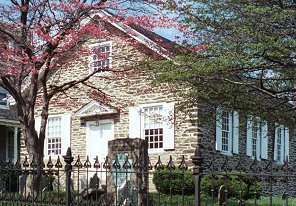Randy Nyce
gmht@meetinghouse.info
Mennonites have long memories. As director for the Historic Mennonite Meetinghouse in Philadelphia’s Germantown neighborhood I have the privilege of sharing those memories and hearing the longing that many have to find their connections with the stories of the past.
Over the years the stories of Germantown and the first permanent Mennonite settlement in America have taken a deep significance in my life. The sacrifice and commitment of that first group of Mennonites who created what has been called “the gateway for Mennonites in America†is a story worth repeating.
Some of those stories were gathered into a book published this winter entitled Colonial Germantown Mennonites. Written by longtime Germantown Mennonite Historic Trust board members, Jan Gleysteen and Leonard Gross, the book, complete with photos and map, invites the reader to stroll through these historic neighborhoods. The Tour Guide section is couched within a short history of the Germantown Mennonites, describing in colorful fashion the life and faith of the first German immigrants in the “New World.â€
Colonial Germantown Mennonites is a meaningful cue of the value that memory has to remind us of where we have been and lead us confidently to the new works that await us. I doubt that many of those gathered in that log meetinghouse for the first baptisms and communion in America considered what they were birthing. Through their actions and commitment, the Mennonite Church in the Americas began.
Our collective memory is a blessing. We remember well the stories of those who have laid a solid foundation for today’s church. I am incredibly thankful to have grown up with the stories of people like Dirk Willems and Clayton Kratz. Both have inspired me and serve as motivation to live a life that is fully devoted to the way of Jesus.
We hold our stories close and rightfully so as they provide us with deep roots that give us the security and identity to venture into new places. They have been the fire around which we gathered strength in the time when Mennonites were branded as a sect of seditious fanatics. But, the reality for the Mennonite Church in America is, as a whole, we are no longer a persecuted people.
I wonder whether our deep devotion and sense of identity inadvertently keeps some at arms length. Held too closely, our history can become a barrier defining who is in and who is out. Are we willing to expand our stories to include the stories of our Asian and African brothers and sisters for whom persecution is not a far off story to remember? How can their stories become ours, and ours become theirs?

When the Israelites crossed the Jordan and entered the Promised Land, they built an altar at Gilgal as a reminder of the wondrous work that God had done. As the years went by when they wandered past that sacred place they remembered and told their children the stories of how God had moved in their midst.
So it is with our stories of faith. Germantown is the Gilgal from where the American Mennonite stories began. With confidence in a God who has delivered us faithfully in the past, we can boldly move to the future creating new stories and inviting others to join us.
The opinions expressed in articles posted on Mosaic’s website are those of the author and may not reflect the official policy of Mosaic Conference. Mosaic is a large conference, crossing ethnicities, geographies, generations, theologies, and politics. Each person can only speak for themselves; no one can represent “the conference.” May God give us the grace to hear what the Spirit is speaking to us through people with whom we disagree and the humility and courage to love one another even when those disagreements can’t be bridged.
